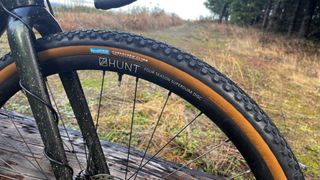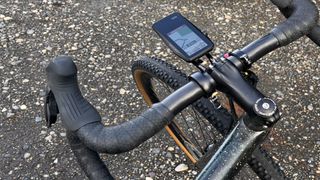After three years of research and development, René Herse, known for its high-performance bicycle tyres and components, has launched its first semi-slick tyre model.
Semi-slick designs are commonplace in gravel cycling, and René Herse readily acknowledges its late arrival to the category, stating: “we have a lot of respect for pioneers who came before us. We also have a healthy degree of scepticism when faced with groupthink and innovations that don’t make sense. That’s why, until now, there hasn’t been a semi-slick gravel tyre in the René Herse program. Simply put, the established way to make semi-slicks resulted in tyres that were neither particularly fast, nor did they grip particularly well.”
With its all-new Corkscrew Climb model, René Herse promises to deliver “not just another semi-slick” but rather a tyre that’s meant to be the best of both worlds: fast like slicks, grippy like knobbies.
Brand owner Jan Heine tells Cycling Weekly that the Corkscrew Climb was developed in response to the demands and insights of professional gravel racers.
“We’re lucky to get direct feedback from our racers…They love the speed and durability of our casings—that’s why they chose our tyres. They like riding slicks on most courses, figuring that the least tread also has the least resistance. But if it’s muddy, they need knobs. For that, they’ve been using our dual-purpose knobbies.”
While the knobbed René Herse tyres are praised for their speed, Heine revealed that in internal testing, they discovered that under high power outputs, the knobs can flex and squirm slightly, leading to power loss. While this isn’t much of a concern for most riders, it does become an issue for athletes like Ted King or Brennan Wertz, who are taller, heavier and frequently produce outputs of more than 500 watts during races.
And so, the design team went to work. Three years later, the result is a 700 x 44mm semi-slick tyre with a slick centre for efficiency, three rows of large knobs and a rounded profile for traction. The tyre is named after the biggest climb of the SBT GRVL race, the Corkscrew Climb.
The latest race content, interviews, features, reviews and expert buying guides, direct to your inbox!
“A few years ago, Ted King won there on our slicks, but the new Corkscrew Climb would be even better-suited to this ultra-fast course,” commented Heine.
The tyre design is different enough from other market offerings that four different patent filings protect it.
A patent-protected design
(Image credit: Rene Herse)
When looking at the Corkscrew Climb tyre, there are a few main design features that stand out:
– there’s a slick centre with a subtle chevron tread that, Heine says, is meant to improve braking performance;
– a gradual transition from slick to knobs thanks to a row of half nobs anchored to the slick centre;
– two rows of large, rectangle knobs that are staggered for noise-cancelling benefits. Heine says the large knobs flex less and are faster than smaller knobs;
– the centre and knobs are the same height.
– a rounded profile.

(Image credit: Rene Herse)
René Herse has filed for four different patents to protect its design, including:
1: the gradual transition
The gradual transition from its slick centre to large shoulder knobs is meant to provide predictable traction and handling when entering a corner – on- and off-road.
2: The anchored half knobs
As stated above the first row of knobs are about half the size of the other knobs and attached to the slick centre tread. This is meant to produce stiffer knobs with better traction under high power. Less flex of the knobs also reduces rolling resistance.
3: A rounded profile
Despite its large shoulder knobs, the Corkscrew Climb tyre maintains a rounded profile because the radius of the tread is significantly larger than the radius of the tire casing. This curvature puts more rubber on the road when leaning into a turn for better traction, while the side knobs stay off the ground when riding in a straight line, minimising rolling resistance.
4: noise reduction
While not unique to this model, the staggered knobs are meant to create overlapping noise frequencies that partially cancel each other, making René Herse tyres quieter than knobbed tyres of competing brands.
Specs & Availability

(Image credit: Anne-Marije Rook)
The Corkscrew Climb tyre will be available starting mid-Jabuary directly from the René Herse website and its stockists.
As with most René Herse models, the tyre will be available in four casing options and two different sidewall colours.
- Size: 700 x 44
- All casings are tubeless compatible
- Casings, weights, prices:
- Standard: 517g, $82
- Extralight: 481g, $96
- Endurance: 552g, $96
- Endurance Plus: 564g, $104
First Ride Impressions:

(Image credit: Anne-Marije Rook)
Like so many high-end, niche brands, René Herse (formerly known as Compass Cycles) is a brand that elicits strong opinions—its loyal fanbase swears by the performance of its products, while critics are quick to voice their concerns.
I, for one, am a fan of René Herse tyres due to their exceptionally supple casings, which not only provide a remarkable ride feel but also reliable traction, a low rolling resistance and superior comfort over rough terrain. I’ve found that both the traction and speediness often belie the tyre width or tread pattern. By that, I mean that the slicks have more grip than one would expect –even on the occasional singletrack detour– and the knobs and width don’t feel sluggish when you hit the pavement.
That said, they’re not without their challenges. There have been reports of inconsistent quality and blow-offs, and, personally, I avoid the Extralight casing as it tends to be more prone to punctures and sidewall weepage. Additionally, if you’re frequently swapping tyres, some René Herse models can be tricky to remount and seat once they’ve been used. They’re also very spendy.
Nevertheless, the advantages outweigh the disadvantages. The ride quality is simply that good, and I typically have a set or two in my rotation, whether it’s a set of the 31mm Orondo Grade, 38mm Barlow Pass or 48mm Oracle Ridge.
I was intrigued to see the brand venture into the semi-slick category and keen to try the new rubbers myself. I live in the Pacific Northwest, and it’s that time of year when rain falls by the bucket loads and gravel rides turn into giant mud fests. Popular semi-slick models like the popular Schwalbe G-One RS, Specialized Pathfinder and Panaracer SS simply don’t cut it in these conditions. The knobs are too small, too low and spaced too tightly for the mud, grime and slippery surface transitions.
With large, generously spaced knobs, the Corkscrew Climb tyre looks far beefier than any of its competitors in the semi-slick category. It pairs the rectangle knobs as seen on the Hurricane Ridge or Oracle Ridge models with a 17mm-wide slick centre that features a very subtle chevron tread.
For my test set, I opted for the Endurance casing. The tyres came in slightly underweight and measured a rather narrow 44mm on 21mm internal width rims. A wider rim (25mm or more) should allow the tyre to expand to its full width.
The tubeless setup was a breeze, and thus far, the tyres have held air very well.
My initial rides were limited but covered a good mix of surfaces: smooth and cracked pavement, hardpack gravel and downright sloppy trails. The grip is certainly there, even in the muck, and the tyres roll well. Quieter also than the Oracle Ridge tyres I’d usually ride in these wet conditions.
The Corkscrew feels faster than its all-knob siblings, though that’s purely anecdotal at this stage.
I will never produce the kind of power output of riders like Ted King or Brennan Wertz. I, therefore, can’t claim to have actually, tangibly, experienced the power-diminishing flex of knobs that these semi-slicks aim to address. But, being well acquainted with René Herse tyres, the Corkscrew Climb tyre does feel like it has a touch more rigidity than its all-knob or slick siblings. Still supple, just ever so slightly less cushy. Of course, tyre pressure, rim material and rim width all play a factor here, so that’ll give me something to play with in the coming winter months.
While I’ve yet to put significant mileage on this tyre, my first impressions are favourable. It’s a fast-rolling tyre that delivers reliable cornering traction in wet conditions. But existing models—both within and outside the René Herse lineup—offer similar benefits. So the question is: does this semi-slick design surpass the brand’s “dual-purpose knobs,” which are also touted as equally fast on pavement and dirt?
In striving to deliver ‘the best of both worlds,’ there’s always the risk of compromising performance in one area—or both. I look forward to logging more rides on the Corkscrew Climb tyres and finding out whether this new model can live up to its promise.